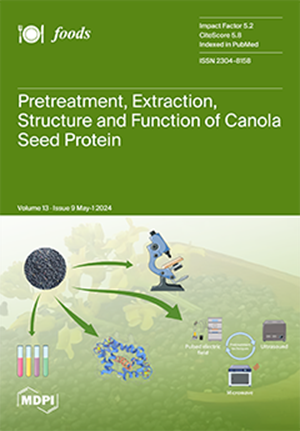加入茶多酚的电纺魔芋葡甘聚糖/聚乙烯醇长聚合物丝用于食品保鲜
IF 4.7
2区 农林科学
Q1 FOOD SCIENCE & TECHNOLOGY
引用次数: 0
摘要
本研究以聚乙烯醇(PVA)和魔芋葡甘聚糖(KGM)为原料,通过电纺丝技术制备了纳米纤维膜。在上述基质中加入了茶多酚(TPs),从而提高了纳米纤维膜的理化性能(热性能和机械性能)和抗菌性能。在不同的食品模拟物中测定了 PVA/KGM-TPs 纳米纤维薄膜中酚类化合物的释放行为,还评估了薄膜的抗氧化和抗菌活性。结果表明,添加 KGM 增加了薄膜的物理和化学特性。拉伸强度(TS)和断裂伸长率(EB)分别从 5.40 ± 0.33 增加到 10.62 ± 0.34,从 7.24 ± 0.32 增加到 18.10 ± 0.91。PVA/KGM-TPs 纳米纤维膜可控制 TPs 的释放,在 3% 乙酸中的最终释放率为 49.17%,在 10% 乙醇中的释放率为 43.6%,在 95% 乙醇中的释放率为 59.42%。纳米纤维薄膜具有良好的抗氧化性,自由基清除率从 1.33% 提高到 25.61%,同时还具有良好的抗菌性,对大肠杆菌和金黄色葡萄球菌的抑菌区分别为 24.33 ± 0.47 mm 和 34.33 ± 0.94 mm。此外,所制备的薄膜在 25 °C条件下对生香蕉具有显著的保鲜性能。本文章由计算机程序翻译,如有差异,请以英文原文为准。
Electrospun Konjac Glucomannan/Polyvinyl Alcohol Long Polymeric Filaments Incorporated with Tea Polyphenols for Food Preservations
In this study, nanofiber films were prepared by electrospinning technology with polyvinyl alcohol (PVA) and konjac glucomannan (KGM) as raw materials. Tea polyphenols (TPs) were incorporated in the above matrix, which increased physicochemical (thermal and mechanical characteristics) and antibacterial properties of the nanofiber films. The release behavior of phenolic compounds from PVA/KGM-TPs nanofiber films was determined in different food simulants; antioxidant and antibacterial activity of the films were also evaluated. The results showed that the addition of KGM increased the physical and chemical properties of the films. The tensile strength (TS) and elongation at break (EB) increased from 5.40 ± 0.33 to 10.62 ± 0.34 and from 7.24 ± 0.32 to 18.10 ± 0.91, respectively. PVA/KGM-TPs nanofiber films performed controlled release of TPs, with final release of 49.17% in 3% acetic acid, 43.6% in 10% ethanol, and 59.42% in 95% ethanol. The nanofiber films showed good antioxidation properties, with the free radical scavenging rate increasing from 1.33% to 25.61%, and good antibacterial properties with inhibition zones against E. coli and S. aureus of 24.33 ± 0.47 mm and 34.33 ± 0.94 mm, respectively. In addition, the as-prepared films showed significant preservation performance for raw bananas at 25 °C.
求助全文
通过发布文献求助,成功后即可免费获取论文全文。
去求助
来源期刊

Foods
Immunology and Microbiology-Microbiology
CiteScore
7.40
自引率
15.40%
发文量
3516
审稿时长
15.83 days
期刊介绍:
Foods (ISSN 2304-8158) is an international, peer-reviewed scientific open access journal which provides an advanced forum for studies related to all aspects of food research. It publishes reviews, regular research papers and short communications. Our aim is to encourage scientists, researchers, and other food professionals to publish their experimental and theoretical results in as much detail as possible or share their knowledge with as much readers unlimitedly as possible. There is no restriction on the length of the papers. The full experimental details must be provided so that the results can be reproduced. There are, in addition, unique features of this journal:
manuscripts regarding research proposals and research ideas will be particularly welcomed
electronic files or software regarding the full details of the calculation and experimental procedure, if unable to be published in a normal way, can be deposited as supplementary material
we also accept manuscripts communicating to a broader audience with regard to research projects financed with public funds
 求助内容:
求助内容: 应助结果提醒方式:
应助结果提醒方式:


